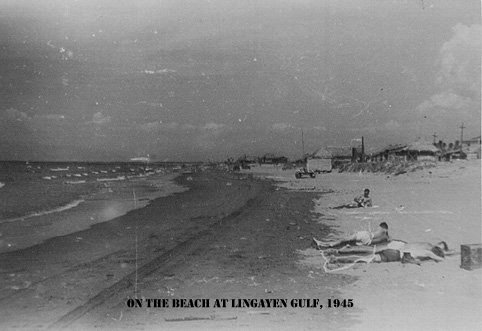9FS Unit History
February 1945
| The 9th got off to a bad start this month when 2nd Lt.
J. Forgey,
returning from a routine convoy escort mission, crashed when making his approach to Hill
strip. He informed his wingman by radio that he was in trouble, and a few seconds later
his plane crashed and exploded; he was unable to get out prior to the crash and perished
in the accident. The first several days of February were uneventful; only local patrol missions were flown. A reconnaissance flight to Alabat Island thoroughly strafed Perez strip on the northwest tip Feb. 6th. The following day four of our planes made a fighter sweep of Cagayan Valley. When passing an enemy strip at Tuguegarao the flight spotted a Sally bomber and 2 single engine fighters on the airdrome. After about 15 strafing passes all 3 planes were left burning. February 8th the squadron sent 13 planes on a dive bombing mission to Luzon. Targets on lower Bataan Peninsula were hit and Corregidor Island bombed with good results. On the 12th, 14 of our planes dropped 1000 lb. bombs on the same targets with excellent results. The following day the 9th had two fighter sweeps of the Cagayan Valley. One flight strafed Tuguegarao Airdrome again, destroying 3 enemy fighters on the ground. The other flight attacked Aparri Airdrome, also destoying 3 fighters on the strip. February 14th a rumor arose that our Group was to exchange camps with the 18th Fighter Group, 13th Air Force, located at Lingayen on Luzon. For almost a week this rumor bounced around and was denied consistently. On 16 February cover was maintained over the beach-head at Nasugbu, Luzon, but the enemy made no appearance. On this day the news came that our Navy planes were attacking Tokyo in great strength. Needless to say, this news occasioned great elation. The squadron made a fighter sweep to Formosa on Feb. 17, but again no sign of enemy air activity was observed. Jesselton Airdrome on Borneo was the target for the 9th the next day, a mission escorting A-20's. The bombers turned back when about half way to the target due to poor weather at their altitude. Our planes continued on and thoroughly strafed Kudet and Jesselton Airdromes, destroying several planes and trucks; they also damaged two luggers off-shore. The 19th of February turned out to be a bad day for the squadron, which was covering the Visayan C-47 routes with two plane flights all day long. Lt. Bud Tiffany and his wingman, Lt. H. Thorson, flew over Silay runway on Negros at a low altitude, peeled up and came back over the strip. Lt. Tiffany called Lt. Thorson on the radio after the peel-up, but on the second pass he looked back and saw a P-38 burning beside the runway. Lt. Thorson was not seen after the radio conversation, and cause of the crash will probably remain unknown. Lt. N. Williams and his wingman Lt. J. Kinsman, were in the vicinity of Talisay Airdrome near Silay when Lt. Kinsman's plane developed coolant trouble while at 4,000 feet. Lt. Williams advised his wingman to bail out, and Kinsman replied he intended to do so. Unfortunately, he was unable to leave the plane until it had fallen to 100 feet from the ground. His parachute failed to open in that short distance and Lt. Kinsman landed about 100 yards behind his plane with his parachute strung out before him. He was killed instantly and his body recovered by Filipinos. No sign of enemy action was noted in either instance. Both men were new to the squadron. The 49th Group had a mission to run a fighter sweep to Kagi on Formosa; Lt. Col. Johnson leading. The 9th did not reach the target as they covered a PBM engaged in rescuing a B-25 crew which was forced down in the water by North Island in Luzon Strait. The survivors were picked up without incident and the squadron returned to base as they were low on fuel. The squadron was off for maintenance and training on the 21st, a most welcome breather for the engineering department which had been working long and well to keep the planes in the air. Local patrols were flown the following two days and on the 24th of February the unit was once more off to do the necessary chores preliminary to the forthcoming move to Luzon. |
ON THE BEACH - LINGAYEN GULF

| 9FS Quarters on Lingayen Gulf within 50' of the beach - 1945. (c/o Ken Clark) |




